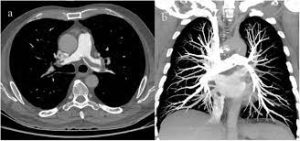 CTPA is a medical diagnostic test that employs computed tomography to obtain an image of the pulmonary arteries.
CTPA is a medical diagnostic test that employs computed tomography to obtain an image of the pulmonary arteries.
Utilizes an intravenous injection of an iodine-containing contrast agent at a high-rate using a injector pump and images are acquired of the pulmonary arteries.
Shows the contrast filling the pulmonary vessels, with filling defects indicating abnormalities such as an embolus.
An alternative to ventilation/perfusion scanning, which relies on radionuclide imaging of the blood vessels of the lung.
Highly sensitive and specific test for pulmonary embolism, and performed if pulmonary embolism is suspected clinically.
In 2007 2.6 million CT plmonary angiograms performed in the US.
Associated with overdiagnosis, that is detection of an abnormality that will never cause symptoms or death.
Use of CTPA has increased prevalence of diagnosis of PE 81%, from 62 to 112 cases per 100,000, decreased mortality of PE by 3% to 11.9 per 100,000 cases, decrease in case fatality rate by 36%, and increase in presumed complications of anticoagulation (Wiener RS et al).
Other studies, however, suggest that increase utilization of such testing has not been commensurate with improvement in pulmonary embolism associated outcomes.
Chest CT angiography is not completely benign and there is significant radiation exposure, and the potential for induction of contrast induced nephropathy.
Inappropriate imaging may lead to an anti-coagulation complication in patients that have subclinical pulmonary emboli, and is an important concern.
